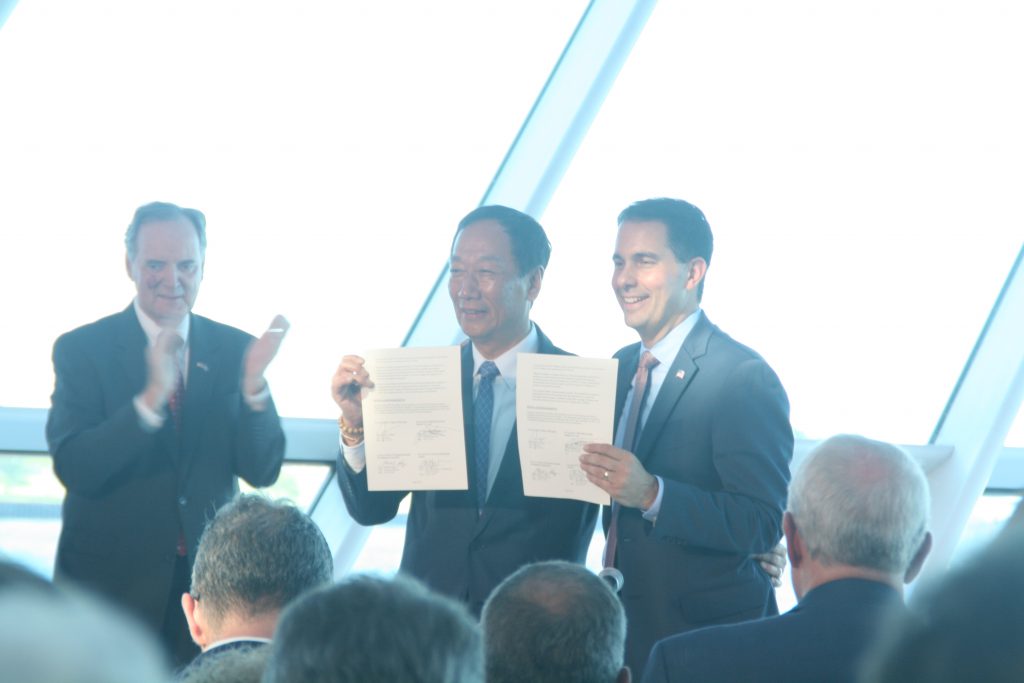10 Tough Questions About Foxconn Deal
Why legislators are squirming about whether to vote for it.

Foxconn chairman Terry Gou and Governor Scott Walker hold a memorandum of understanding. Photo by Jeramey Jannene.
It’s crunch time for Wisconsin legislators on Gov. Scott Walker’s deal that would give the high-tech giant Foxconn $3 billion in tax breaks, if it builds a $10-billion manufacturing facility in southeast Wisconsin that could employ up to 13,000 in a few years.
With an Assembly vote on the package – the biggest-ever economic development deal between state government and a business – tentatively scheduled for Thursday, here are 10 questions that make legislators squirm.
1: Will my vote help or hurt me in the next election?
If Foxconn breaks ground on the facility by election day in November 2018, a picture of the construction site, and a total of how many employees the company has by then, might make a good TV ad justifying a vote for the deal. But voting “yes” means trusting a deal negotiated by the Walker and Trump administrations with a Taiwan business tycoon.
If you vote no, and Foxconn breaks ground and starts hiring, imagine the TV ads that will run against your before the election: “Foxconn wanted to help return Wisconsin to manufacturing greatness. [Your name here] said, ‘No’.”
2: What financial legacy do I leave my kids and grandkids?
A state Department of Administration forecast –using the most optimistic estimates – predicted that the “break even” year for the deal won’t be until 2042-43. That’s when all tax breaks given Foxconn will finally be outweighed by increased tax revenues resulting from the company’s investments.
Senate Majority Leader Scott Fitzgerald said the 2042-43 estimate was “striking,” and one reason the Foxconn package didn’t have enough Senate votes to pass last week.
In short, what happens after 15 years?
“They can do whatever they want after that 15-year period,” argues Democratic Rep. Chris Taylor, a member of the Legislature’s Joint Finance Committee.
4: What message does $3-billion plus in tax breaks send to tax-paying corporations?
The bill also includes $12.5 million in tax breaks to Fiserv to encourage it to keep its headquarters in Wisconsin. The $3 billion Foxconn tax break, although paid out over 15 years, totals more than three times the $940 million in corporate income taxes other businesses are expected to pay this year.
5: How long will Foxconn’s plant operate, given the short lifespans of electronic products?
The Foxconn plant in Wisconsin would make liquid crystal displays, but how long will they play a dominant role in high-tech communications? A 28-page summary of the Foxconn deal by the nonpartisan Legislative Fiscal Bureau (LFB) raised that issue: “Technological advances and changes in Foxconn’s market share, operating procedures, or product mix could significantly affect employment and wages at the proposed facility over time.”
After all, weren’t state officials once promised that GM vehicles would “always” be built at the Janesville assembly plant? It closed two days before Christmas 2008.
6: Will there be changes to the bill before Legislators vote?
Will the Assembly Jobs and the Economy Committee recommend changes before Thursday’s vote that make the deal more acceptable? Or will those changes be shot down because Walker and Foxconn warn they could kill the deal?
7: Could – and should – Wisconsin’s Investment Board buy into Foxconn, giving it an equity stake?
“If I’m going to give you money, then I want some ownership,” said Democratic Rep. Jason Fields, who said the deal as written offered Wisconsin only “wishes and prayers.”
The state’s public employees rely on growth in the pension fund overseen by the state investment board for their retirements. Is a Foxconn investment a smart decision to help recoup the taxpayers’ investment or too risky a choice for such a fund?
8: What is the impact on the environment?
Besides exempting a new Foxconn plant from an environmental impact study, what other concessions – for filling in wetlands and diverting Lake Michigan water, for example – are part of the deal?
9: What enforcement does the deal have?
Why does the deal’s fine print say state government “may” – and not “must” – clawback or try to recover past tax breaks, if Foxconn cashes those refundable tax-break checks and then leaves Wisconsin?
10: Can any financial estimates projected as far into the future as 2043 be trusted?
Especially when they come from Foxconn and from Walker loyalists at the state Department of Administration?
“Any cash-flow analysis that covers a period of nearly 30 years must be considered highly speculative,” the LFB analysis warned.
It will be a tough vote. “My Facebook page comments say ‘no’,” one Kenosha County lawmaker says. “But the people I meet on the street want it.”
Steven Walters is a senior producer for the nonprofit public affairs channel WisconsinEye. Contact him at stevenscwalters@gmail.com
More about the Foxconn Facility
- Murphy’s Law: Total Cost of Foxconn Is Rising - Bruce Murphy - Dec 8th, 2025
- WEDC, Foxconn announce additional $569 million investment in Racine County - Wisconsin Economic Development Corporation - Nov 25th, 2025
- Foxconn Acquires 20 More Acres in Mount Pleasant, But For What? - Joe Schulz - Jan 7th, 2025
- Murphy’s Law: What Are Foxconn’s Employees Doing? - Bruce Murphy - Dec 17th, 2024
- With 1,114 Employees, Foxconn Earns $9 Million in Tax Credits - Joe Schulz - Dec 13th, 2024
- Mount Pleasant, Racine in Legal Battle Over Water After Foxconn Failure - Evan Casey - Sep 18th, 2024
- Biden Hails ‘Transformative’ Microsoft Project in Mount Pleasant - Sophie Bolich - May 8th, 2024
- Microsoft’s Wisconsin Data Center Now A $3.3 Billion Project - Jeramey Jannene - May 8th, 2024
- We Energies Will Spend $335 Million on Microsoft Development - Evan Casey - Mar 6th, 2024
- Foxconn Will Get State Subsidy For 2022 - Joe Schulz - Dec 11th, 2023
Read more about Foxconn Facility here
Political Contributions Tracker
Displaying political contributions between people mentioned in this story. Learn more.
The State of Politics
-
A Wisconsin Political Trivia Quiz
 Dec 15th, 2025 by Steven Walters
Dec 15th, 2025 by Steven Walters
-
The Fight Over Wisconsin’s House Districts
 Dec 8th, 2025 by Steven Walters
Dec 8th, 2025 by Steven Walters
-
The Battle Over On-Line Betting
 Nov 24th, 2025 by Steven Walters
Nov 24th, 2025 by Steven Walters




















This deal is very much like the county’s(Racine/Waukesha/Milw) decision to build Miller Park. Where did all this development come south of the Park. I am sure the left will state that it would have appeared with out the building of Miller park, but they argue the Trolley Loop downtown will create the same effect. It is not just about FoxConn and the 13,000 jobs . It is about what economic spheres that will be created by the shear size of FoxConn. Liberals want tech jobs in Wisconsin maybe Foxconn can help create that environment.
To date the Walker administration has a poor record of economic development and job creation. We have mortgaged the economic and environmental future of our children and grandchildren with drastic corporate tax cuts, neglect of infrastructure, and corporate giveaways. Our state budget is a mess due to unrealistic revenue projections. The same as he did in Milwaukee County, the governor is using tricks to balance a budget. This 3B deal will pass because the governor wants it. I can only hope and pray it will be part of a positive legacy for the Governor.
–
-And the Miller Park sales tax still goes on. What was the original promised end date of that scheme?
-The conservatives now give up the right to criticize anyone for ” government picking winners & losers”.
Jason, since the streetcar route was finalized, downtown has seen a spate of development, disproportionately within a block or two of the eventual tracks.
BTW, the phrase “trolley loop” is inaccurate because there is neither a “trolley” nor a “loop”.
A “trolley” was the diagonal black pole on an old streetcar’s roof which connected to the overhead wire. Trolleys were unreliable (when they slipped off the wire, the streetcar stalled). Another problem with trolleys was that they worked in one direction only; each streetcar needed two trolley poles, one in use and one tucked away. When an old streetcar changed directions at the end of the line, it either had to drive around the block to turn around (like a bus) or the driver had to go outside and manually swap trolley poles. Either alternative wasted time and increased operating expenses.
Milwaukee’s streetcar has no trolley. It will have a “pantograph” instead a different device that cannot slip off the wire and works equally well in both directions.
Milwaukee’s first streetcar route will have no loop; the streetcar will just go back and forth without ever turning around (one reason it will be faster than a bus on the same route, since buses must waste time turning around). Streetcars can do this because they are double-ended—each end has its own headlights, taillights, windshield wipers and driver’s seat. Streetcars never go in reverse; they go forward in both directions.
Take a look at the over $17 billion of development that has taken place in the Twin Cities along the 2 streetcar lines and RBT lines. The projections were for $20 billion by 2020. That figure will be easily met long before 2020. Investment in infrastructure in a huge boost to economic development.